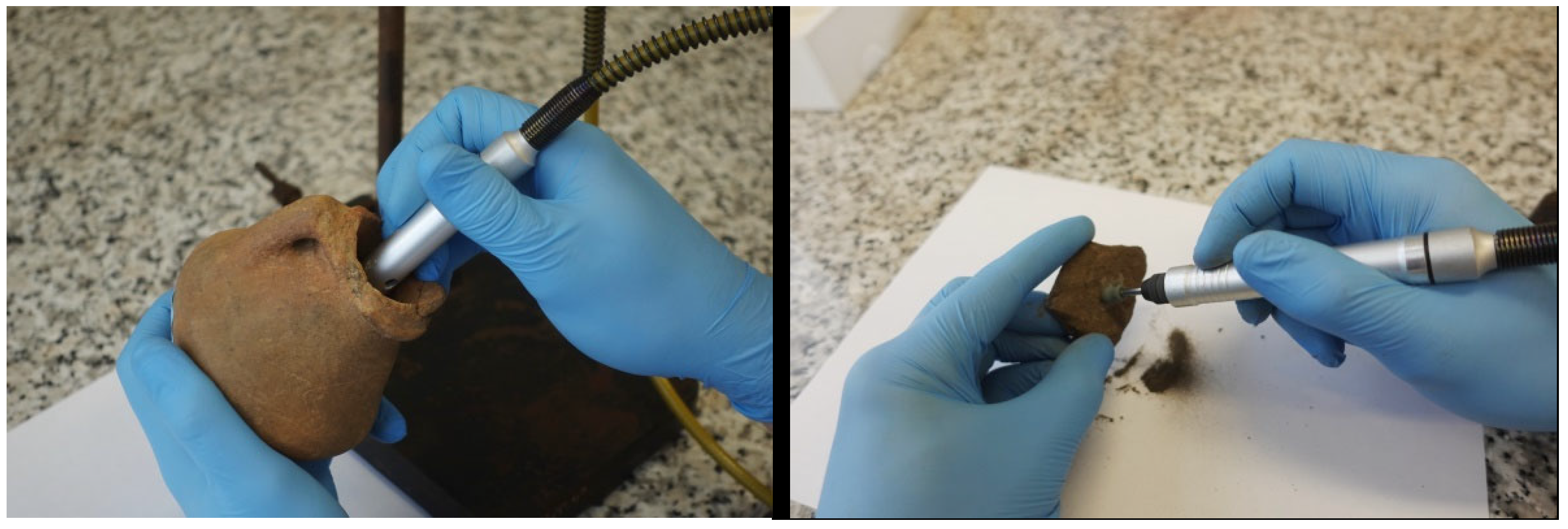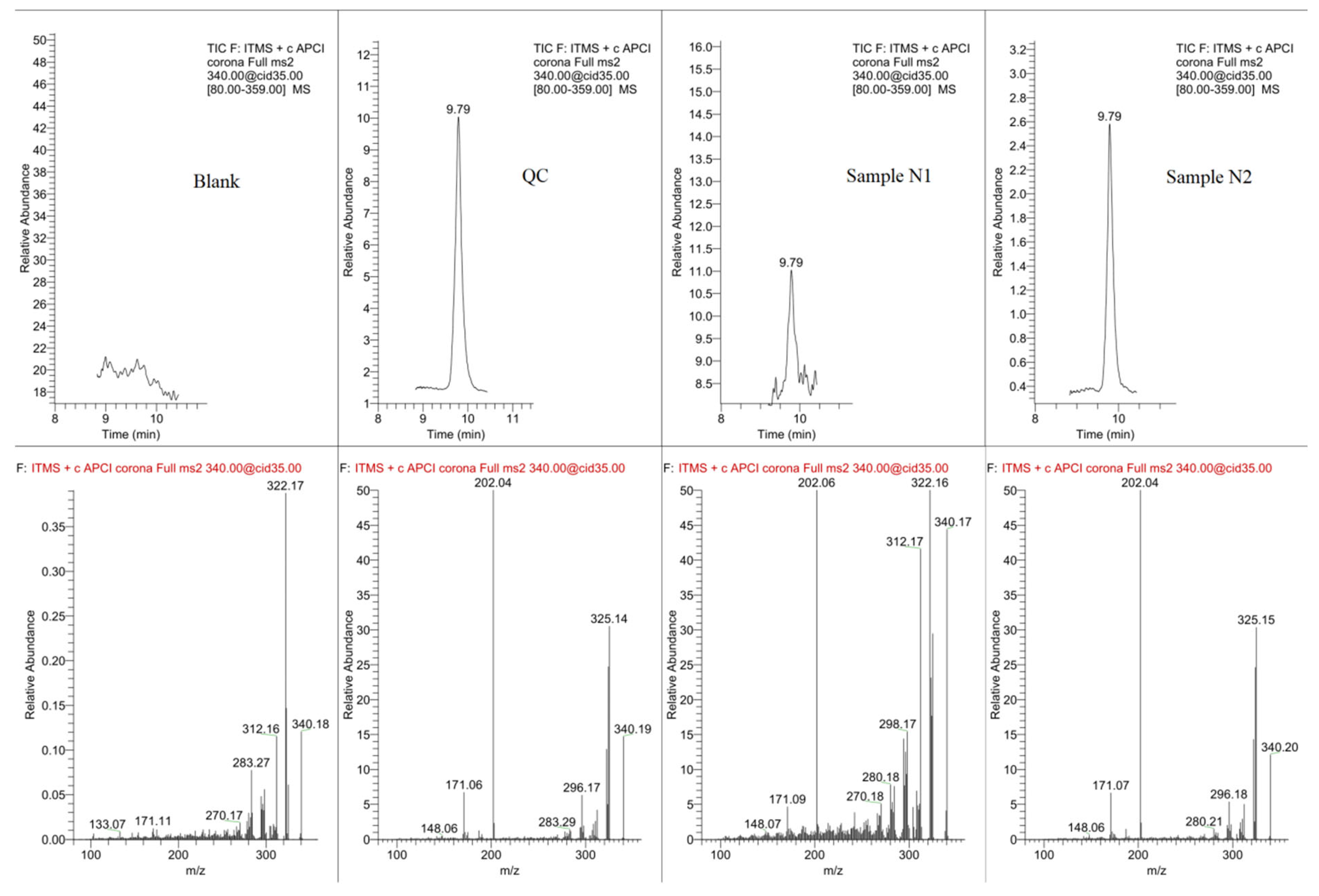GC-MS/MS and LC-MS/MS Identification of Opium and Tropane Alkaloids in Pottery from Funnel Beaker Culture Sites in South-Eastern Poland
Abstract
1. Introduction
2. Methods
2.1. Materials
2.2. Chemicals
2.3. Preparation of Pottery Samples
3. Instrumentation
3.1. GC-MS/MS Analysis
3.2. LC-MS/MS Analysis
4. Validation
5. Results
5.1. Alkaloids Isolation from Pottery
5.2. Validation Results
5.3. Determination of Alkaloids in Actual Pottery Samples
5.3.1. GC-MS/MS Instrumental Analysis
5.3.2. LC-MS/MS Instrumental Analysis
6. Discussion
7. Conclusions
Author Contributions
Funding
Institutional Review Board Statement
Informed Consent Statement
Data Availability Statement
Conflicts of Interest
Abbreviations
| APCI | Atmospheric Pressure Chemical Ionization |
| BSTFA | N,O-Bis(trimethylsilyl)trifluoroacetamide |
| CID | Collision-Induced Dissociation |
| CV | Coefficient of Variation |
| EI | Electron Ionization |
| FBC | Funnel Beaker Culture |
| FT-IR | Fourier Transform Infrared Spectroscopy |
| GC-MS | Gas Chromatography–Mass Spectrometry |
| GC-MS/MS | Gas Chromatography–Tandem Mass Spectrometry |
| HPLC-MS | High-Performance Liquid Chromatography–Mass Spectrometry |
| HQC | High-Level Quality Control |
| ID | Inner Diameter |
| IS | Internal Standard |
| LC-MS | Liquid Chromatography–Mass Spectrometry |
| LC-MS/MS | Liquid Chromatography–Tandem Mass Spectrometry |
| LLOQ | Lower Limit of Quantitation |
| LOD | Limit of Detection |
| LQC | Low-Level Quality Control |
| MQC | Mid-Level Quality Control |
| MRM | Multiple Reaction Monitoring |
| MS | Mass Spectrometry |
| MS/MS | Tandem Mass Spectrometry |
| m/z | Mass-to-Charge Ratio |
| PTFE | Polytetrafluoroethylene |
| QC | Quality Control |
| Rt | Retention Time |
| SRM | Selected Reaction Monitoring |
| TMCS | Trimethylchlorosilane |
| UHPLC | Ultra-High-Performance Liquid Chromatography |
References
- Washburn, D.K.; Washburn, W.N.; Shipkova, P.A.; Pelleymounter, M.A. Chemical analysis of cacao residues in archaeological ceramics from North America: Considerations of contamination, sample size and systematic controls. J. Archaeol. Sci. 2014, 50, 191–207. [Google Scholar] [CrossRef]
- Roffet-Salque, M.; Dunne, J.; Altoft, D.T.; Casanova, E.; Cramp, L.J.; Smyth, J.; Whelton, H.L.; Evershed, R.P. From the inside out: Upscaling organic residue analyses of archaeological ceramics. J. Archaeol. Sci. Rep. 2017, 16, 627–640. [Google Scholar] [CrossRef]
- Merlin, M.D. Archaeological Evidence for the Tradition of Psychoactive Plant Use in the old world. Econ. Bot. 2003, 57, 295–323. [Google Scholar] [CrossRef]
- Kałużna-Czaplińska, J.; Rosiak, A.; Kwapińska, M.; Kwapiński, W. Different Analytical Procedures for the Study of Organic Residues in Archeological Ceramic Samples with the Use of Gas Chromatography-mass Spectrometry. Crit. Rev. Anal. Chem. 2016, 46, 67–81. [Google Scholar] [CrossRef] [PubMed]
- Vincenti, F.; Montesano, C.; Ciccola, A.; Serafini, I.; Favero, G.; Pallotta, M.; Pagano, F.; Di Francesco, G.; Croce, M.; Leone, M.L.; et al. Unearthed opium: Development of a UHPLC-MS/MS method for the determination of Papaver somniferum alkaloids in Daunian vessels. Front. Chem. 2023, 11, 1238793. [Google Scholar] [CrossRef] [PubMed]
- Irto, A.; Micalizzi, G.; Bretti, C.; Chiaia, V.; Mondello, L.; Cardiano, P. Lipids in Archaeological Pottery: A Review on Their Sampling and Extraction Techniques. Molecules 2022, 27, 3451. [Google Scholar] [CrossRef] [PubMed]
- Rosiak, A.; Kałużna-Czaplińska, J.; Gątarek, P. Analytical Interpretation of Organic Residues From Ceramics as a Source of Knowledge About Our Ancestors. Crit. Rev. Anal. Chem. 2020, 50, 189–195. [Google Scholar] [CrossRef] [PubMed]
- Samorini, G. The oldest archeological data evidencing the relationship of Homo sapiens with psychoactive plants: A worldwide overview. J. Psychedelic Stud. 2019, 3, 63–80. [Google Scholar] [CrossRef]
- King, A.; Powis, T.G.; Cheong, K.F.; Deere, B.; Pickering, R.B.; Singleton, E.; Gaikwad, N.W. Absorbed Residue Evidence for Prehistoric Datura Use in the American Southeast and Western Mexico. Adv. Archaeol. Pract. 2018, 6, 312–327. [Google Scholar] [CrossRef]
- Smith, R.K.; Stacey, R.J.; Bergström, E.; Thomas-Oates, J. Detection of opium alkaloids in a Cypriot base-ring juglet. Analyst 2018, 143, 5127–5136. [Google Scholar] [CrossRef] [PubMed]
- Presley, C.C.; Lindsley, C.W. DARK Classics in Chemical Neuroscience: Opium, a Historical Perspective. ACS Chem. Neurosci. 2018, 9, 2503–2518. [Google Scholar] [CrossRef] [PubMed]
- Nowak, M. The Funnel Beaker Culture in Western Lesser Poland: Yesterday and Today. Archaeol. Pol. 2019, 57, 79–101. [Google Scholar] [CrossRef]
- Taras, H.; Zakościelna, A.; Osak, M.; Buszewicz, G.; Teresiński, G. A Contribution to the Study of Traces of Psychotropic Substances Inside Miniature Vessels and Collared Flasks of the Eneolithic Funnel Beaker culture (FBC) from Poland. Analecta Archaeol. Ressoviensia 2023, 18, 97–102. [Google Scholar] [CrossRef]
- Nowak, M.; Lityńska-Zając, M.; Hoyo, M.M.; Mueller-Bieniek, A.; Kapcia, M.; Kotynia, K. Plants of the Funnel Beaker culture in Poland. Spraw. Archeol. 2020, 72, 87–114. [Google Scholar] [CrossRef]
- Litzinger, W.J. Ceramic evidence for prehistoric datura use in North America. J. Ethnopharmacol. 1981, 4, 57–74. [Google Scholar] [CrossRef] [PubMed]
- Nesměrák, K.; Kudláček, K.; Babica, J. Analytical chemistry studying historical pharmaceuticals and health care formulations. Monatshefte Chem.-Chem. Mon. 2017, 148, 1557–1568. [Google Scholar] [CrossRef]
- Guerra-Doce, E.; Rihuete-Herrada, C.; Micó, R.; Risch, R.; Lull, V.; Niemeyer, H.M. Direct evidence of the use of multiple drugs in Bronze Age Menorca (Western Mediterranean) from human hair analysis. Sci. Rep. 2023, 13, 4782. [Google Scholar] [CrossRef] [PubMed]
- Ordoñez-Araque, R.; Ruales, J.; Vargas-Jentzsch, P.; Ramos-Guerrero, L.; Romero-Bastidas, M.; Montalvo-Puente, C.; Serrano-Ayala, S. Pre-Hispanic Periods and Diet Analysis of the Inhabitants of the Quito Plateau (Ecuador): A Review. Heritage 2022, 5, 3446–3462. [Google Scholar] [CrossRef]
- Linares, V.; Jakoel, E.; Be’eri, R.; Lipschits, O.; Neumann, R.; Gadot, Y. Opium trade and use during the Late Bronze Age: Organic residue analysis of ceramic vessels from the burials of Tel Yehud, Israel. Archaeometry 2022. [Google Scholar] [CrossRef]







| Sample Name | Pottery Information | |
|---|---|---|
| Location | Affiliation | |
| D1 | Dubeczno 1, Włodawa district | miniature |
| D2 | miniature | |
| D3 | miniature | |
| D4 | miniature | |
| D5 | miniature | |
| D6 | miniature | |
| G1 | Gródek 1C, Hrubieszów district | miniature |
| G2 | miniature | |
| G3 | miniature | |
| N1 | Nałęczów Plateau, Puławy district | collared flask |
| N2 | Zgórzyńskie, Puławy district | collared flask |
| W1 | Wąwolnica 7, Puławy district | collared flask |
| Sample Set of Silylated Compounds | |||||
|---|---|---|---|---|---|
| Name | Rt | Mass | Product Mass | Collision Energy | Ion Polarity |
| Atropine-TMS | 7.13 | 361.3 | 82.1 | 20 | Positive |
| 124.1 | 5 | ||||
| 140.1 | 10 | ||||
| Scopolamine-TMS | 7.71 | 375.3 | 136.1 | 20 | |
| 138.1 | 10 | ||||
| 154.1 | 5 | ||||
| Codeine-TMS | 8.22 | 234.2 | 162.1 | 20 | |
| 371.3 | 146.1 | 25 | |||
| 214.1 | 30 | ||||
| Morphine-D6-diTMS (IS) | 8.44 | 239.1 | 149.1 | 10 | |
| 435.2 | 293.1 | 15 | |||
| Morphine-diTMS | 8.46 | 236.2 | 146.1 | 10 | |
| 429.3 | 234.2 | 10 | |||
| 401.2 | 10 | ||||
| Sample Set of Native Compounds | |||||
| Name | Rt | Mass | Product Mass | Collision Energy | Ion Polarity |
| Fentanyl (IS) | 9.55 | 245.2 | 146.1 | 15 | Positive |
| 189.2 | 10 | ||||
| Papaverine | 10.12 | 338.3 | 278.1 | 35 | |
| 307.2 | 10 | ||||
| 322.1 | 15 | ||||
| Compound | Analytical Limits (ng/g) | |||
|---|---|---|---|---|
| GC-MS/MS | LC-MS/MS | |||
| LOD | LLOQ | LOD | LLOQ | |
| Atropine | 0.1 | 0.3 | 1 | 3 |
| Scopolamine | 0.04 | 0.12 | 8 | 24 |
| Morphine | 0.04 | 0.12 | 5 | 15 |
| Codeine | 0.04 | 0.12 | 5 | 15 |
| Papaverine | 0.1 | 0.3 | 1 | 3 |
| Compound | % Recovery | % Matrix Effect | ||
|---|---|---|---|---|
| GC-MS/MS | LC-MS/MS | GC-MS/MS | LC-MS/MS | |
| Atropine | 54.4 | 63.5 | 103.4 | 158.4 |
| Scopolamine | 47.2 | 63.8 | 133.6 | 153.6 |
| Morphine | 50.0 | 57.8 | 240.8 | 375.2 |
| Codeine | 45.9 | 44.4 | 249.6 | 253.1 |
| Papaverine | 76.8 | 77.7 | 207.8 | 137.1 |
| Average | 54.9 | 61.4 | 187.0 | 215.5 |
| Sample Name | Analytical Results-Compounds Detected by Method | |
|---|---|---|
| GC-MS/MS | LC-MS/MS | |
| D1 | negative but probable-atropine (not confirmed by result below LOD), positive-scopolamine | negative |
| D2 | negative | negative |
| D3 | negative | negative |
| D4 | negative | negative |
| D5 | negative | negative |
| D6 | negative | negative |
| G1 | negative | negative |
| G2 | positive-papaverine | negative |
| G3 | negative | negative |
| N1 | positive-papaverine | positive-papaverine |
| N2 | positive-papaverine | positive-papaverine |
| W1 | negative | negative |
Disclaimer/Publisher’s Note: The statements, opinions and data contained in all publications are solely those of the individual author(s) and contributor(s) and not of MDPI and/or the editor(s). MDPI and/or the editor(s) disclaim responsibility for any injury to people or property resulting from any ideas, methods, instructions or products referred to in the content. |
© 2025 by the authors. Licensee MDPI, Basel, Switzerland. This article is an open access article distributed under the terms and conditions of the Creative Commons Attribution (CC BY) license (https://creativecommons.org/licenses/by/4.0/).
Share and Cite
Osak, M.; Buszewicz, G.; Taras, H.; Zakościelna, A.; Teresiński, G.; Karpiński, R.; Baj, J. GC-MS/MS and LC-MS/MS Identification of Opium and Tropane Alkaloids in Pottery from Funnel Beaker Culture Sites in South-Eastern Poland. Materials 2025, 18, 5316. https://doi.org/10.3390/ma18235316
Osak M, Buszewicz G, Taras H, Zakościelna A, Teresiński G, Karpiński R, Baj J. GC-MS/MS and LC-MS/MS Identification of Opium and Tropane Alkaloids in Pottery from Funnel Beaker Culture Sites in South-Eastern Poland. Materials. 2025; 18(23):5316. https://doi.org/10.3390/ma18235316
Chicago/Turabian StyleOsak, Marcin, Grzegorz Buszewicz, Halina Taras, Anna Zakościelna, Grzegorz Teresiński, Robert Karpiński, and Jacek Baj. 2025. "GC-MS/MS and LC-MS/MS Identification of Opium and Tropane Alkaloids in Pottery from Funnel Beaker Culture Sites in South-Eastern Poland" Materials 18, no. 23: 5316. https://doi.org/10.3390/ma18235316
APA StyleOsak, M., Buszewicz, G., Taras, H., Zakościelna, A., Teresiński, G., Karpiński, R., & Baj, J. (2025). GC-MS/MS and LC-MS/MS Identification of Opium and Tropane Alkaloids in Pottery from Funnel Beaker Culture Sites in South-Eastern Poland. Materials, 18(23), 5316. https://doi.org/10.3390/ma18235316








